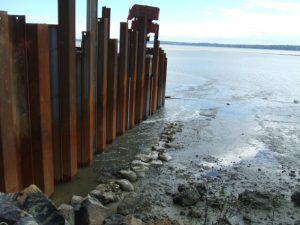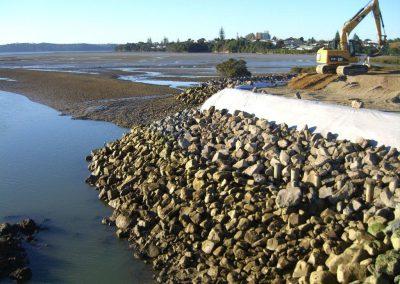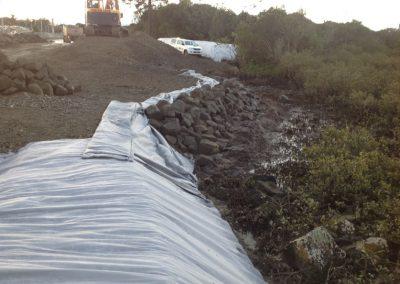Specific Tasks
Coastal MarineReclamation and coffer dams
Issues to look out for
It is considered best practice to isolate the works from the receiving environment – eg with coffer dams – but this is often very difficult to achieve. Even if coffer dams can be constructed, they are very difficult to seal and tidal water will continue to seep up under the dams through the marine muds. Coffer dams are significant structures and will require engineering design by a suitably qualified and experienced structural engineer.
Whether or not you need to isolate the works area is determined both by the activity to take place and the reclamation material to be used. For example, using a clean aggregate significantly reduces the risk of any sediment discharges from the reclamation operation. On the other hand, using clay reclamation material can cause problems because the clays can mobilise during placement.
Using fill material as reclamation is also a geotechnical challenge, to create structural integrity of the fill. Binding agents such as lime or cement will work but you need to carefully assess the mixing of these additives to check whether it is likely for these contaminants to mobilise and then discharge.
If you cannot isolate the works effectively, then the methodology and staging you use becomes even more critical.
Design essentials
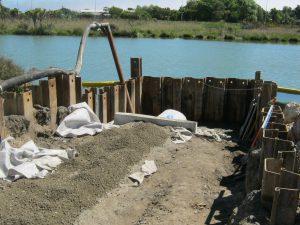
Coffer dam isolates the work area around a pipe being installed in an estuary (Source: Fulton Hogan).
Consider the following points when planning and designing for reclamation activities:
- Plan the works to minimise both the extent and duration of the reclamation.
- Consider using ‘clean’ backfill materials to minimise the potential for sediment discharges.
- Consider in detail the stabilisation options. Where possible, avoid using stabilising products.
- If stabilisation products are needed as part of the ground improvements, then you may need a coffer dam to isolate the works from the marine environment. Consider where the contaminated water within the works zone will be pumped for treatment.
Reclamation works are likely to require works within the tide cycles, which creates a challenging working environment where preparation and planning are critical. The ground improvement requirements will largely determine the options available to undertake the works.
Stabilising products
If you are using stabilising products like lime or cement within the CMA, you must isolate the works area from the coastal receiving environment by using a coffer dam to protect the area from the tide until the products have cured and the area is stabilised.
While you are stabilising, water within the works zone will be contaminated so will need to be pumped to a secure area for treatment or for removal offsite – ‘secure’ means that it will not be inundated during a storm event. Product transfer areas will need to be bunded and secure.
-
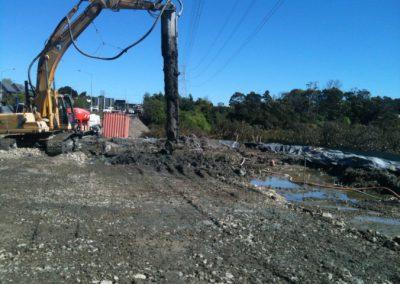
Coffer dam made of marine mud and covered in polyethene to allow for the deep soil mixing to happen in the dry (Source: SouthernSkies).
-
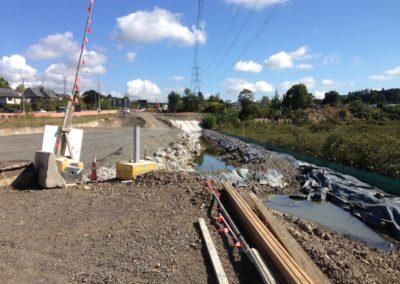
The marine mud coffer dam remained in place until all works were completed (Source: SouthernSkies Limited).
Reclamation materials
If you do not need stabilising products, it is the type of reclamation material to be used that will determine whether or not you need a coffer dam.
If the reclamation material is erodible, eg clays and silts (general earthworks fill), then the works area must be isolated from the coastal receiving environment with a coffer dam to protect the area from the tide until it is stabilised. During the filling operations, water within the works zone will be sediment-laden and will need to be pumped to a secure area for treatment before it is discharged or removed offsite (see Dewatering section).
If the reclamation product is non-erodible, eg rock and metal, then you can do a staged filling approach during low tide. Using a clean aggregate significantly reduces the risk of any sediment discharges.
When clay, silt or mud material is used and mixed with a binder before being put in the CMA (either offsite or in a barge or other similar device), you may be able to place it without a coffer dam or silt curtain. This is because this material will typically be well bound and is unlikely to be mobilised. (Note: Do a trial with the material to confirm this.)
Geotextiles
The end of each staged section should be protected at the end of each tide cycle with geotextile. Stage a rock face along the coastal face to protect the areas from wave action.
-
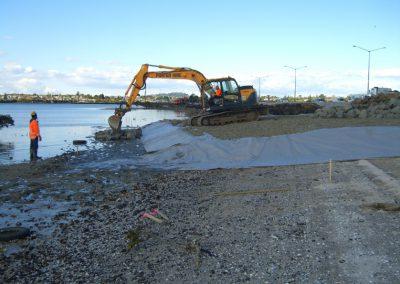
Cloth was laid out during low tide, then covered with aggregate in small longitudinal sections to ensure that, at the end of each tide cycle, the fill is out of the tide and the geotextile is pulled up to protect the face (Source: SouthernSkies Limited).
-

Revetment rock was then placed on the outside face on the incoming tide to protect the seaward face.
